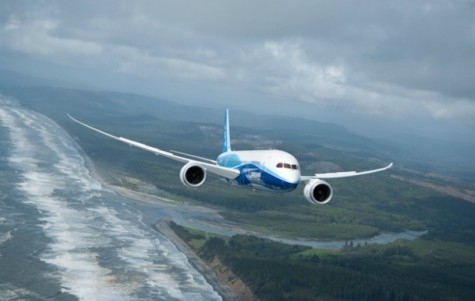Over at Mashable there’s an excellent walkthrough of Boeing’s newest and hottest passenger aircraft, the 787 Dreamliner, and all of its gorgeous interior features that are designed to make passenger air travel more comfortable, less tiring, and more fun than it’s ever been. Make no mistake, the aircraft is utterly gorgeous and I have no doubt in my mind that the aircraft itself is wonderfully built with comfort and smart design in mind with smart design choices from the lighting to the windows–all points that are outlined in the article–but I have my doubts that even the Dreamliner will be able to make flying fun again.
Before we get into why, here’s some more info about the jet. For starters, there’s some great news about the cabin air; something that’s a number one complaint for a lot of flyers:
The 787’s lighter, composite fuselage design means the plane’s pressurization can be changed with no concerns about weight impact.
From a practical point, the 787’s lower pressure cabin should mean a more pleasant flying environment and around 8% more oxygen absorption. This is good news for anyone who suffers from headaches, dizziness, nausea and fatigue when flying.
In addition, the air in a 787 is “cleaner” than other commercial planes. Fresh air comes from “air scoops,” rather than via the engines. In addition to HEPA filtration, the 787 also employs a gaseous filtration system, reducing irritants even further.
Now that’s something I’m thrilled with. It’s never any fun being stuck in an airplane breathing stale, highly pressurized air that you know is being circulated through everyone else’s nostrils and that smells vaguely like jet fuel. The 787 Dreamliner’s vaulted ceilings and bigger windows don’t hurt things at all – they all make the jet more fun to be on and more open and comfortable once you’re on board.
That is, provided that airlines and government officials are willing to let the jet stay that way, and to smooth over the passenger’s experience getting to their flight. As it stands right now, the biggest problem with air travel is the fact that it’s so painful to get into the airport, through security, and to your flight that people just don’t want to do it anymore. If you do it regularly for business or out of necessity you quickly grow an immunity to it, but that doesn’t make it much easier. The rigor and fear surrounding the security theater of TSA checkpoints in the United States at least still makes for an incredibly unpleasant pre-flight experience, one that airlines and airports do little to alleviate once you’re through security and on your way to your gate or terminal.
Then, to make matters worse, the airlines will surely take all of the wonderful technological improvements in the Dreamliner and scrap them all in favor of packing in as many passengers as humanly possible with little to no regard for the design and comfort that Boeing engineers put into their work. The beautiful seating arrangements and wide on-deck desks that you see in the concept art at Mashable will likely be replaced with rows upon rows upon rows of seats that airlines can shamelessly overbook and pack people into so tightly that the only admiration they’ll have for the vaulted ceiling is when they look up to see it – mostly because they’ll have passengers less than 6 inches to their sides, a headrest immediately behind them, and the next passenger’s seat a few feet from their face.
Still, I can only hope that some of the improvements that Boeing has made to the Dreamliner make their way into the commercial versions of the jets. There’s a big difference between the concept jets and the first-flight jets that are carefully built to showcase the technology and design of the manufacturer and the final commercial products ordered (and heavily tweaked) by airlines. The question isn’t really whether the Dreamliner can make flying fun again, but whether the airlines will allow it to do so.
[ Mashable :: Boeing 787 Dreamliner: Can a High-Tech Jet Make Flying Enjoyable Again? ]

